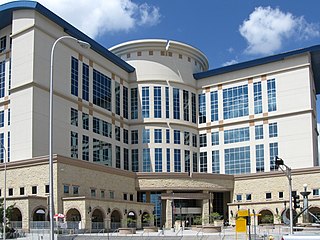
Bernalillo County is the most populous county in the U.S. state of New Mexico. As of the 2020 census, the population was 676,444. The county seat, Albuquerque, is the most populous city in New Mexico.

Albuquerque High School is a public high school near Downtown Albuquerque, New Mexico, United States. It is a part of the Albuquerque Public Schools district. Enrollment at AHS stands at 1,741.
Albuquerque Public Schools (APS) is a school district based in Albuquerque, New Mexico. Founded in 1891, APS is the largest of 89 public school districts in the state of New Mexico. In 2022 it had a total of 143 schools with some 70,000 students, making it one of the largest school districts in the United States. APS operates 88 elementary, 5 K-8, 28 middle, 20 high, 31 charter, and alternative schools. They also own the radio station KANW and co-own the TV stations KNME-TV and KNMD-TV along with the University of New Mexico.

San Felipe de Neri Church is a historic Catholic church located on the north side of Old Town Plaza in Albuquerque, New Mexico. Built in 1793, it is one of the oldest surviving buildings in the city and the only building in Old Town proven to date to the Spanish colonial period. The church is listed on the New Mexico State Register of Cultural Properties and the National Register of Historic Places and has remained in continuous use for over 200 years.

Old Town is the historic original town site of Albuquerque, New Mexico, for the provincial kingdom of Santa Fe de Nuevo México, established in 1706 by New Mexico governor Francisco Cuervo y Valdés. It is listed on the New Mexico State Register of Cultural Properties as the Old Albuquerque Historic District, and is protected by a special historic zoning designation by the city. The present-day district contains about ten blocks of historic adobe buildings surrounding Old Town Plaza. On the plaza's north side stands San Felipe de Neri Church, a Spanish colonial church constructed in 1793.
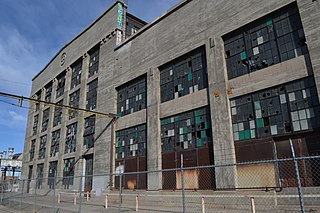
The former Santa Fe Railway Shops in Albuquerque, New Mexico, consist of eighteen surviving buildings erected between 1915 and 1925. The complex is located south of downtown in the Barelas neighborhood, bounded by Second Street, Hazeldine Avenue, Commercial Street, and Pacific Avenue. The shops were one of four major maintenance facilities constructed by the Atchison, Topeka and Santa Fe Railway, the others being located in Topeka, Kansas, Cleburne, Texas, and San Bernardino, California. The railway shops were the largest employer in the city during the railroad's heyday. Currently they have been empty for years but a variety of plans have been proposed for the historic complex.
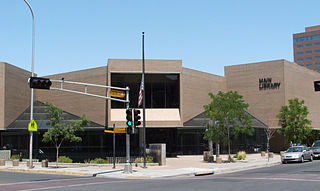
The Albuquerque Bernalillo County Library is the public library system serving greater Albuquerque, New Mexico, United States. It includes seventeen branch libraries as well as the downtown Main Library.
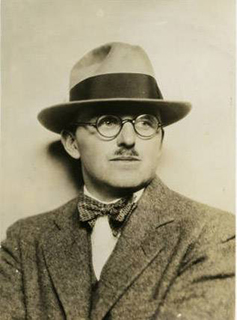
John Gaw Meem IV was an American architect based in Santa Fe, New Mexico. He is best known for his instrumental role in the development and popularization of the Pueblo Revival Style and as a proponent of architectural Regionalism in the face of international modernism. Meem is regarded as one of the most important and influential architects to have worked in New Mexico.

Néstor Montoya was a United States representative from New Mexico. As an editor and politician, Néstor Montoya dedicated himself to the inclusion of Hispanics in the political and social life of New Mexico, and to the campaign for New Mexico statehood.

Maisel's Indian Trading Post was located in the city of Albuquerque, county of Bernalillo, in the U.S. state of New Mexico. It was added to the New Mexico State Register of Cultural Properties and the National Register of Historic Places listings in Bernalillo County, New Mexico in 1993. Maisel’s was closed permanently in late April, 2020, during the COVID-19 shut down.

The Old Armijo School, also known as the Ranchos de Atrisco School, is a historic school building in the South Valley area of Albuquerque, New Mexico. It is notable as one of the only surviving school buildings attributed to Atanasio Montoya, a noted educator who reformed and modernized the Bernalillo County school system in the early 20th century. The school was added to the New Mexico State Register of Cultural Properties and the National Register of Historic Places in 1982.
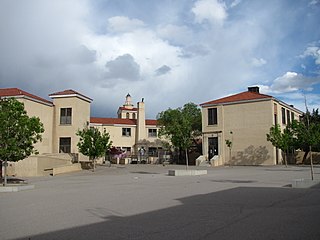
Monte Vista Elementary School is a public elementary school in the Nob Hill neighborhood of Albuquerque, New Mexico, whose campus is listed in the New Mexico State Register of Cultural Properties and the National Register of Historic Places. It is notable as one of the city's best examples of Mediterranean Revival architecture and as the historical focal point of the surrounding neighborhood. It is a part of Albuquerque Public Schools.

West San Jose School, also known as Riverview School, is a historic former elementary school in the Barelas neighborhood of Albuquerque, New Mexico. It was built in 1936–37 as a Works Progress Administration project and operated as a school until 1975. It is now part of the National Hispanic Cultural Center. The building was added to the New Mexico State Register of Cultural Properties and the National Register of Historic Places in 1996.

Scholes Hall is the historic administration building of the University of New Mexico, located on the main campus in Albuquerque. It was the first of many buildings designed for the university by Santa Fe architect John Gaw Meem, who helped to cement the Pueblo Revival style as the "official" architecture of the campus. Built in 1934–36 with Public Works Administration funding, it is regarded as one of Meem's most notable designs.

The Old Main Library is a historic building in the Huning Highlands neighborhood of Albuquerque, New Mexico, originally built in 1925 as the main facility of the Albuquerque Public Library. Since the opening of the current Main Library in 1975, it has served as the library system's Special Collections branch, housing historical and genealogical research materials. Designed by Arthur Rossiter with interior decorations by Gustave Baumann, the building is a notable example of Pueblo Revival architecture. It was added to the New Mexico State Register of Cultural Properties in 1975 and is also an Albuquerque Historic Landmark.

Martineztown-Santa Barbara is a neighborhood in central Albuquerque, New Mexico, immediately northeast of Downtown. Originating as a small farming village in the 1850s, it is one of the city's oldest neighborhoods and retains a distinct character, with winding streets, irregular lots, and adobe vernacular buildings reminiscent of other old Hispanic communities in northern New Mexico.

The Main Library is a public library in Downtown Albuquerque, New Mexico and the main branch of the Albuquerque Bernalillo County Library system. Opened in 1975, it was designed by local architect George Pearl and listed on the National Register of Historic Places in 2019. The library is a concrete-framed Brutalist structure designed to maximize the flexibility of the interior space with a modular layout and movable partitions. Pearl considered it one of his "three or four most important" designs. In 2020, the building was designated an Albuquerque historic landmark.

The Gutiérrez Hubbell House also known as the James Lawrence and Juliana Gutierrez y Chavez Hubbell House, is a historic territorial-style hacienda. The original house dates back to the 1820s, and was enlarged in the 1850s and 1860s. It is located in the village of Pajarito in the South Valley of Albuquerque, New Mexico. The house has existed under three national flags: Spain, Mexico and the United States.
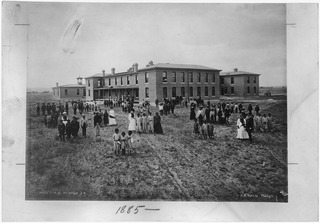
Albuquerque Indian School (AIS) was a Native American boarding school in Albuquerque, New Mexico, which operated from 1881 to 1981. It was one of the oldest and largest off-reservation boarding schools in the United States. For most of its history it was run by the Bureau of Indian Affairs (BIA). Like other government boarding schools, AIS was modeled after the Carlisle Indian Industrial School, using strict military-style discipline to strip students of their native identity and assimilate them into white American culture. The curriculum focused on literacy and vocational skills, with field work components on farms or railroads for boys and as domestic help for girls. In the 1930s, as the philosophy around Indian education changed, the school shifted away from the military approach and offered more training in traditional crafts like pottery, weaving, and silversmithing.


















